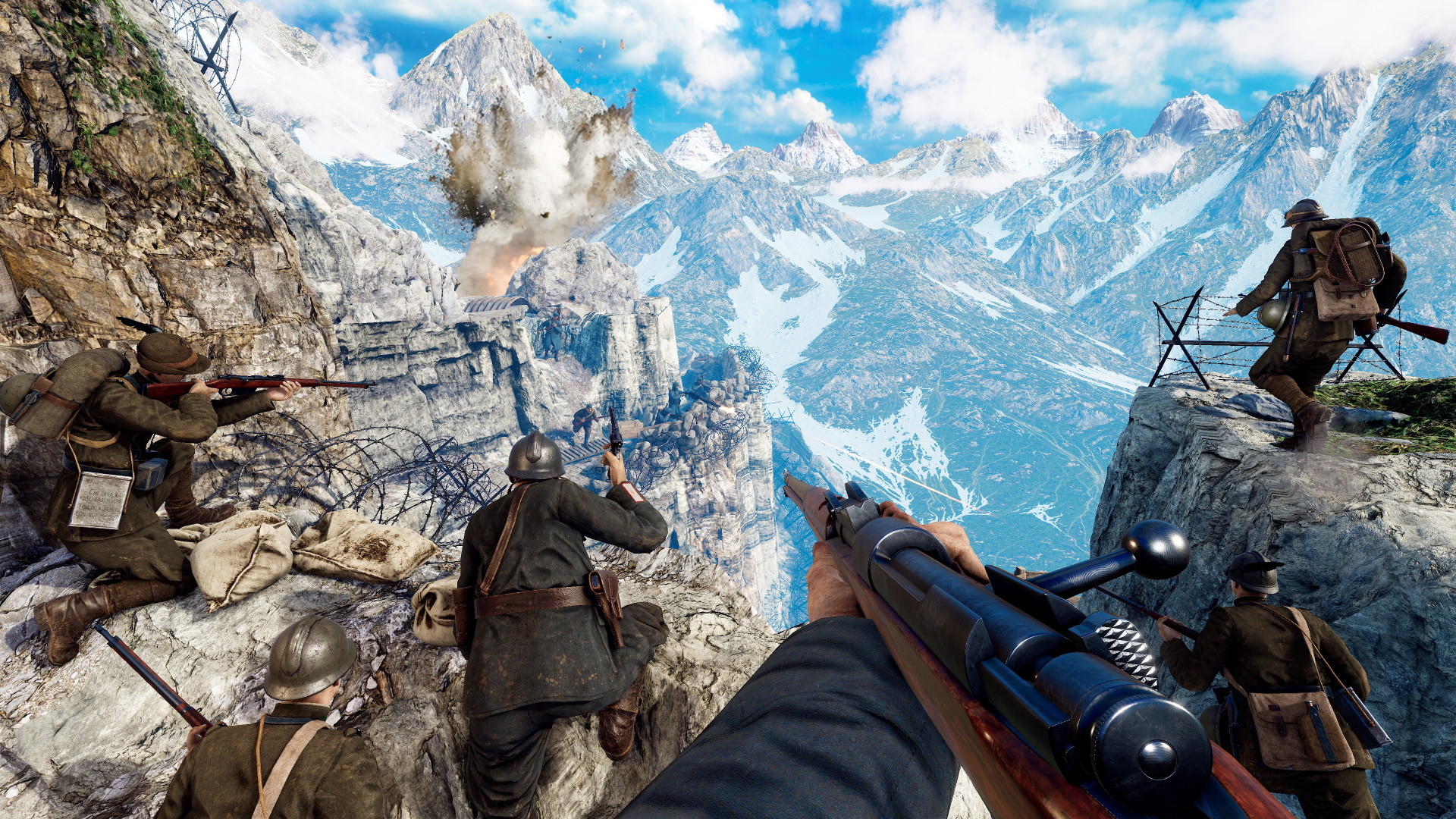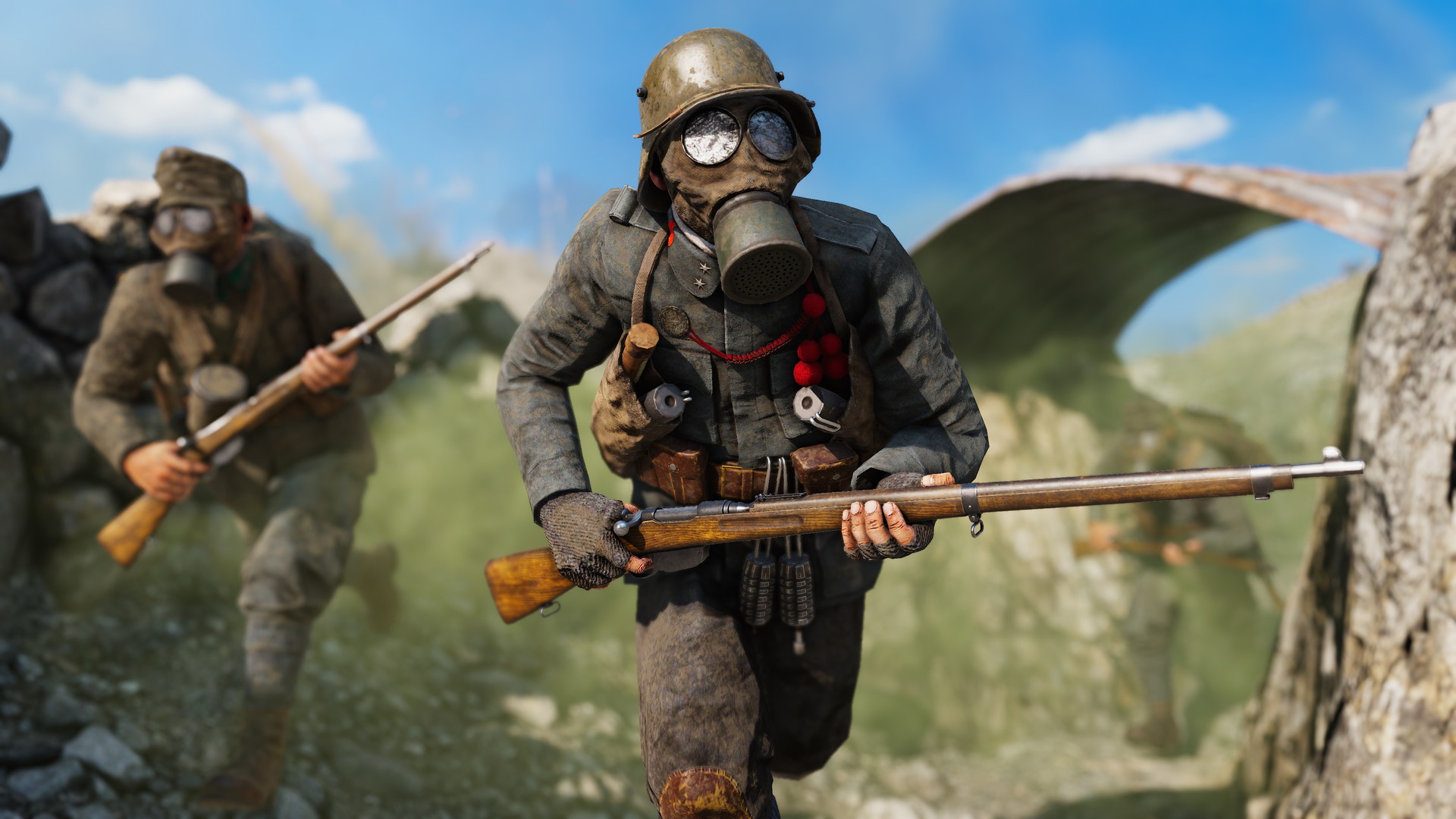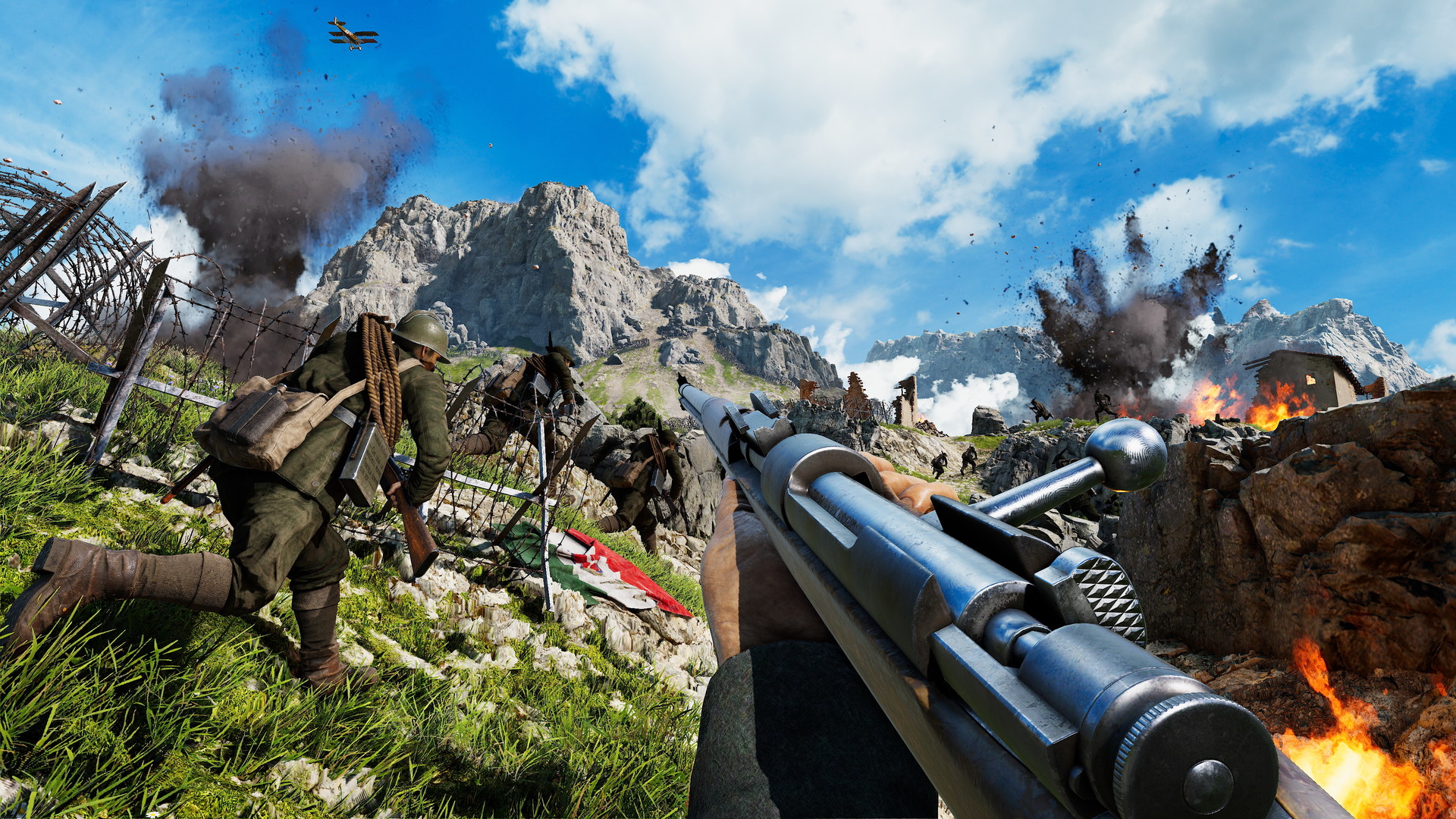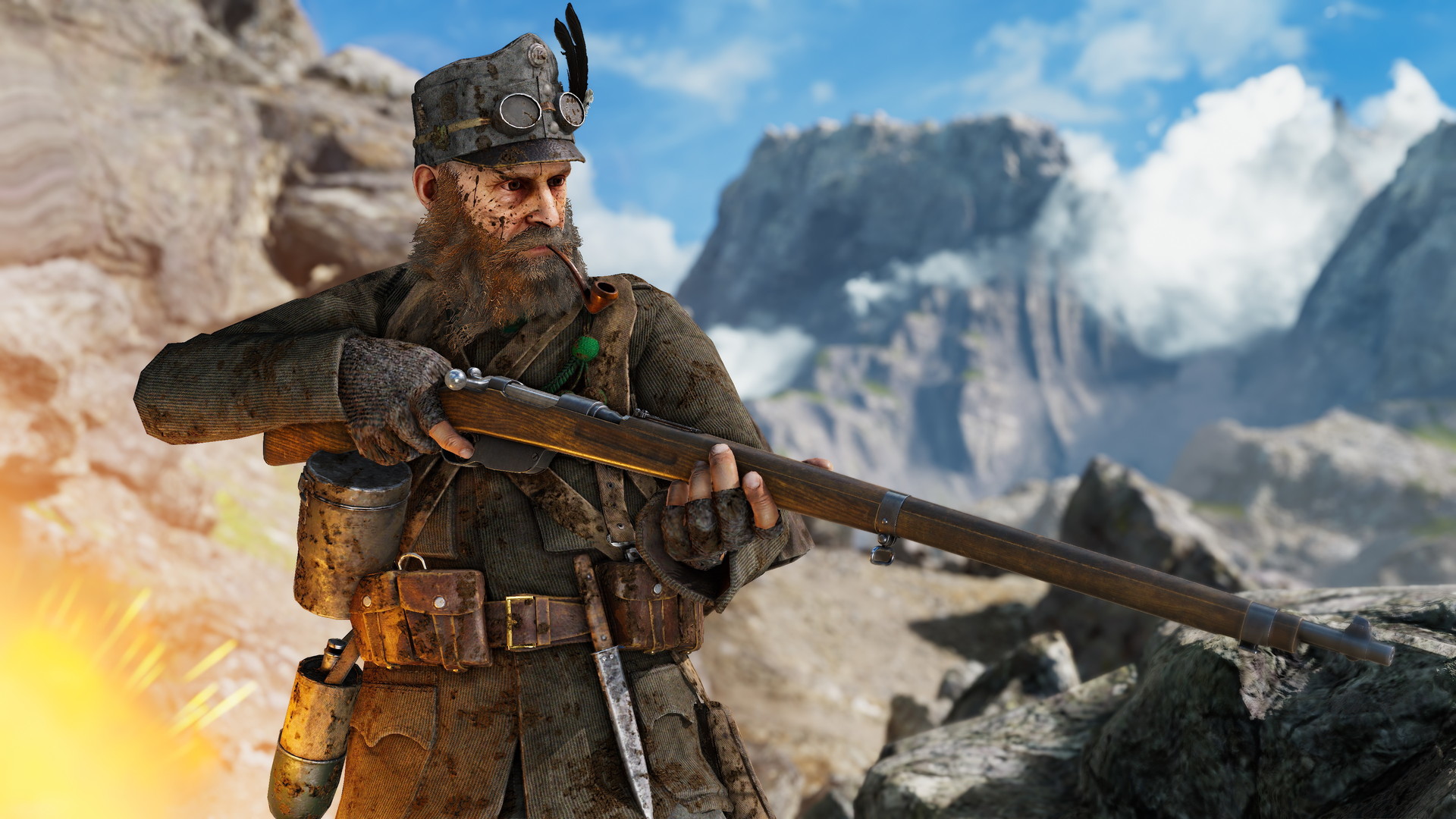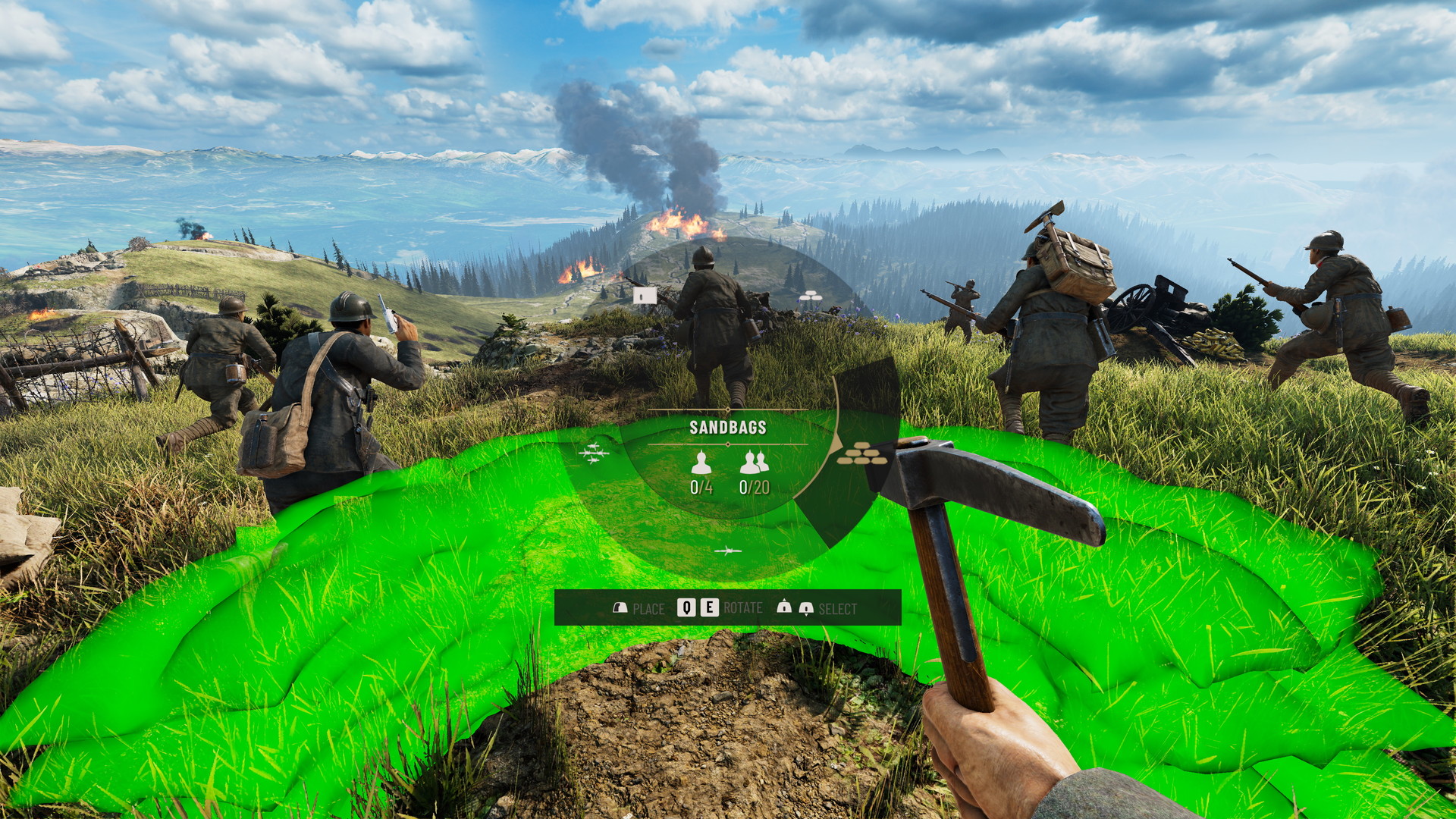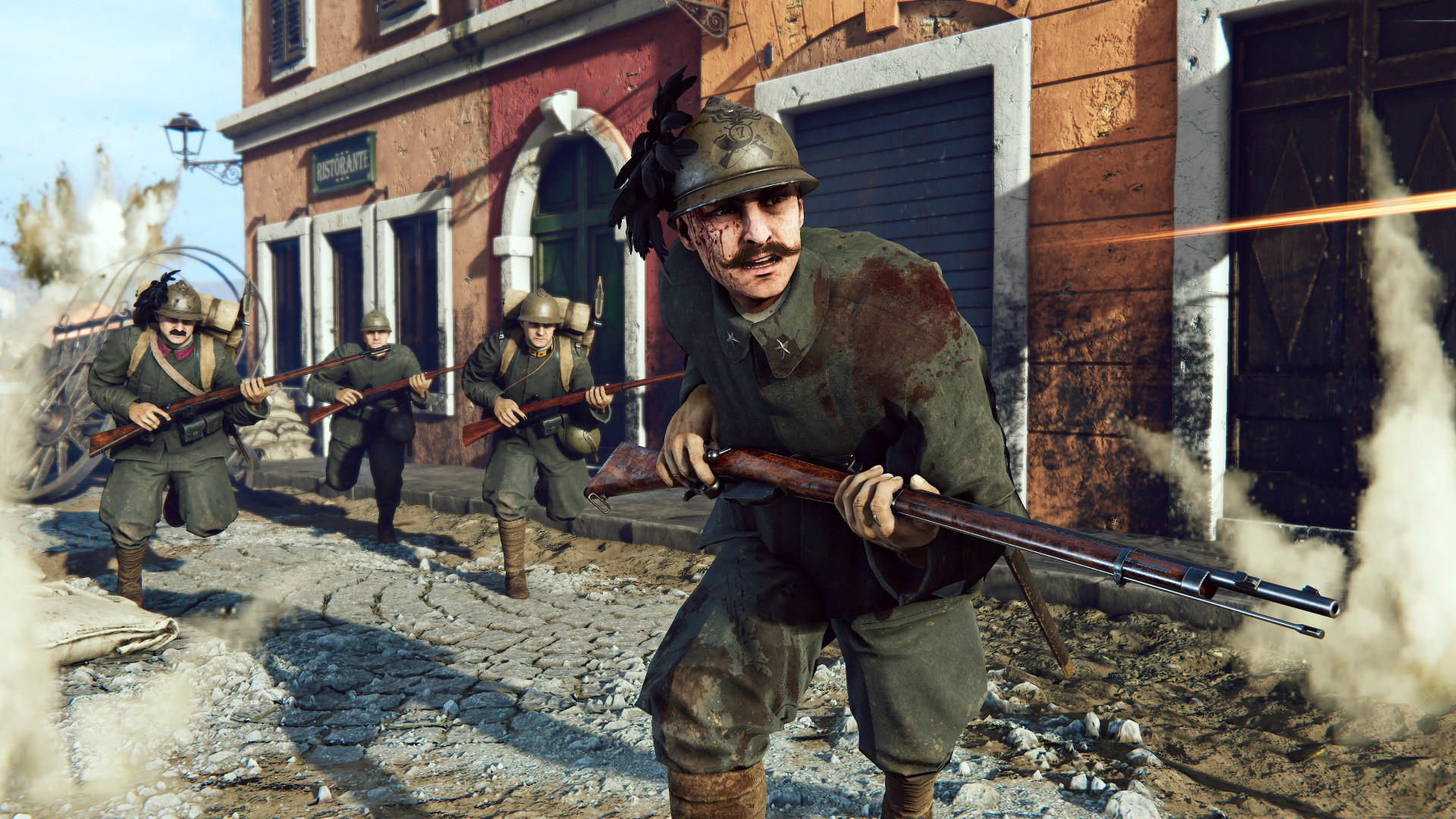World War One expands to the mountains of the Italian Front - beautiful but deadly in equal measure. Inspired by the two year struggle for control of the Isonzo river valley and the Alps during World War One, Isonzo elevates the WW1 Games Series, figuratively and literally.
From the makers of Verdun and Tannenberg …
The new Offensive game mode puts you right in the middle of key historical offensives on the Italian Front. Lead the charge across stunning Italian landscapes as you choose your path to victory - cut paths through barbed wire, flank your enemies by following mountain trails, or man a mortar to blast a way through. Shape a dynamic battlefield by laying sandbags and wire, placing ammo crates, deploying trench periscopes or sniper shields, and more.

Take part in historical offensives from the Sixth Battle of the Isonzo to the Strafexpedition. Reflecting the course of the actual battles, as the attackers advance the fighting will shift through vastly different landscapes within a single offensive: from hillside fortresses to mountain trenches and fierce urban combat on city streets. Everything is recreated based on research and field trips, from sound effects and uniforms down to the houses, vineyards and trenches you’ll be fighting over.
Call in support with a unique historically accurate flare system: flare guns can mark targets for artillery or biplane flybys, or different colored flares can be used to guide your team. Once the big guns have softened up the enemy, finish the job at close quarters with an Arditi dagger or mountaineer’s pickaxe. Man heavy machine guns, mortars and even mountain guns for more direct fire support.

Choose from six classes based on historical combat roles and build your loadout from a selection of weapons, equipment and perks linked to that class, giving flexibility and variety while staying grounded in what real soldiers might have carried. You’ll be operating wire cutters, bandaging yourself and wounded teammates, and blowing the whistle to start an assault. One shot can kill and even lighter injuries can lead to quickly bleeding out.
Being an effective soldier in Isonzo is not just about being a good marksman. Mastering the terrain is also key - the mountain can be a friend or foe. Learn how to navigate well to maintain cover and surprise your enemies or support your allies.
Finally… watch out for the dreaded poison gas. You’ve never experienced WW1 action quite like this!
Isonzo key features include:
More Games in the Authentic WW1 Game Series
Immerse yourself in more WW1 action with our other standalone titles Tannenberg and Verdun. Experience trench warfare on the Western Front in Verdun, or maneuver for control of key sectors in Tannenberg on the Eastern Front. These authentic WW1 shooters let players choose from a range of squads from across the war, as they fight for control of the ever-changing frontlines.
From the makers of Verdun and Tannenberg …
The new Offensive game mode puts you right in the middle of key historical offensives on the Italian Front. Lead the charge across stunning Italian landscapes as you choose your path to victory - cut paths through barbed wire, flank your enemies by following mountain trails, or man a mortar to blast a way through. Shape a dynamic battlefield by laying sandbags and wire, placing ammo crates, deploying trench periscopes or sniper shields, and more.

Take part in historical offensives from the Sixth Battle of the Isonzo to the Strafexpedition. Reflecting the course of the actual battles, as the attackers advance the fighting will shift through vastly different landscapes within a single offensive: from hillside fortresses to mountain trenches and fierce urban combat on city streets. Everything is recreated based on research and field trips, from sound effects and uniforms down to the houses, vineyards and trenches you’ll be fighting over.

Call in support with a unique historically accurate flare system: flare guns can mark targets for artillery or biplane flybys, or different colored flares can be used to guide your team. Once the big guns have softened up the enemy, finish the job at close quarters with an Arditi dagger or mountaineer’s pickaxe. Man heavy machine guns, mortars and even mountain guns for more direct fire support.

Choose from six classes based on historical combat roles and build your loadout from a selection of weapons, equipment and perks linked to that class, giving flexibility and variety while staying grounded in what real soldiers might have carried. You’ll be operating wire cutters, bandaging yourself and wounded teammates, and blowing the whistle to start an assault. One shot can kill and even lighter injuries can lead to quickly bleeding out.
Being an effective soldier in Isonzo is not just about being a good marksman. Mastering the terrain is also key - the mountain can be a friend or foe. Learn how to navigate well to maintain cover and surprise your enemies or support your allies.
Finally… watch out for the dreaded poison gas. You’ve never experienced WW1 action quite like this!
Isonzo key features include:
- Mountain warfare: Assaulting mountain fortifications, battling through ruined towns, and fording rivers are just a few of the challenges you’ll face as you fight your way through numerous enemy positions
- Tactical multiplayer FPS: Choose your role and loadout carefully to survive this high altitude combat - play a sniper to pick off the enemy engineers before they can cut your wire, use rifle grenades to clear enemy machine guns, and much more
- World War One Gameplay: Historical Offensive game mode based on real battles and focused on the unique challenges of Alpine warfare. Fight with 30+ WW1 weapons, poisonous gas attacks, and intense artillery barrages
- Build for victory: Place your own wire, sandbags, trench periscopes, and more! Whether you’re digging in or on the attack, shaping the battlefield to your advantage will be key to victory
- Faces of war: Make every class your own by picking from a variety of historically class-appropriate uniforms, accessories and headgear. As a finishing touch, you can even pick your mustache from several famous period-accurate styles!
- Authentic WW1 atmosphere: Accuracy in everything from maps and weaponry to music and the uniforms – fight for the Kingdom of Italy or the Austro-Hungarian Dual Monarchy

More Games in the Authentic WW1 Game Series
Immerse yourself in more WW1 action with our other standalone titles Tannenberg and Verdun. Experience trench warfare on the Western Front in Verdun, or maneuver for control of key sectors in Tannenberg on the Eastern Front. These authentic WW1 shooters let players choose from a range of squads from across the war, as they fight for control of the ever-changing frontlines.
Dev Blog #21 - Gas! Gas!
 Italian troops advancing under the cover of smoke.
Italian troops advancing under the cover of smoke.
The other smoke option is number three in the list of Chemical Regiment call-ins, and deploys a creeping smoke barrage. Ten shells in a row from the target, using the same aiming system as seen with the creeping artillery barrage. This smoke also lasts 80 seconds, so the advantage to this choice is that you can create a proper smokescreen across a wide area. When you need to cross open ground or could use some cover to destroy enemy obstacles, the creeping smoke barrage will give you the concealment you need.
Tear Gas
The second option in the chemical call-in list is tear gas - something like Xylyl bromide. First used in January 1915 by the Germans against the Russians (some say the French used it in 1914 against the Germans, but that was likely a somewhat different tear gas) it failed utterly due to cold conditions and wind blowing it back towards the German lines. Despite another failure near Nieuwpoort in Belgium, it was easy to manufacture and thus remained in use. Youll also see it described in game as White Cross - this is based on a German designation for any gas that affected eyes and mucous membranes. In Isonzo two shells are deployed, and the gas lingers for 80 seconds, the same duration as smoke. A gas mask provides complete protection.
 Italian soldier using a rudimentary gas mask.
Italian soldier using a rudimentary gas mask.
Phosgene Gas
Classified as a Green Cross gas in that it affected the lungs, phosgene was originally developed in 1812. It was an important part of the chemical industry during the 19th century, and so relatively easy for warring nations to produce. The first major use during the war was by the French in 1915, while the first use on the Italian front was 29 June 1916 when the Austro-Hungarians deployed it against Italian positions on Monte San Michele. It was often mixed with chlorine, because while phosgene was more potent than chlorine, it didnt spread as well - a problem mitigated in a chlorine mix. In Isonzo the phosgene gas call-in deploys 4 shells leaving gas clouds that remain for 95 seconds. It has a stronger effect than the xylyl gas, and will incapacitate soldiers more quickly if they are not wearing their gas mask. Again, wearing a mask will completely protect you.
 Austrians used phosgene gas on Monte San Michele in 1916.
Austrians used phosgene gas on Monte San Michele in 1916.
Mustard Gas
Developed into a military form fairly late into the war (first used by the Germans at Ypres in 1917), mustard gas is so named because it has a strong odor resembling mustard plants or garlic. The gas itself is colorless, but tends to take on the brown-yellow color when mixed with other elements to be a more effective weapon. A particularly toxic compound, mustard gas causes burns to skin, with prolonged exposure leading to the equivalent of second or even third degree burns. Worse, a gas mask alone wont provide full protection, since it can penetrate cotton and wool to burn covered skin.

Gas spreading after shells land.
In Isonzo, mustard gas is the fifth tier Chemical Regiment call-in, where it is deployed in a five shell barrage. The gas remains for 110 seconds. Wearing a gas mask will protect you (at least it can be considered to keep you able to fight despite any longer term effects) but otherwise mustard gas will incapacitate you very quickly indeed. Youll have to drop what youre doing and don a mask immediately!
You can wishlist Isonzo on Steam!
https://store.steampowered.com/app/1556790/Isonzo/
We covered artillery support options in a previous dev blog, and the Chemical Regiment follows the same format with five choices, with later options having increasingly long cooldowns. The chemical warfare options have a slightly longer cooldown than the artillery and aviation call-ins, because gas and smoke remain on the battlefield for longer.
Smokescreens
There are two smoke options available. The most basic Chemical Regiment call-in is a two shell small smoke barrage which will provide a small cloud of smoke that will stay in place for 80 seconds. This is most useful to blind specific enemy strongpoints or heavy weapons. Drop it in front of a machine gun or a bunkers firing slot and youll effectively take them out of the fight for more than a minute! Italian troops advancing under the cover of smoke.
Italian troops advancing under the cover of smoke.The other smoke option is number three in the list of Chemical Regiment call-ins, and deploys a creeping smoke barrage. Ten shells in a row from the target, using the same aiming system as seen with the creeping artillery barrage. This smoke also lasts 80 seconds, so the advantage to this choice is that you can create a proper smokescreen across a wide area. When you need to cross open ground or could use some cover to destroy enemy obstacles, the creeping smoke barrage will give you the concealment you need.
Gas Barrages
While smoke must not be underestimated, we know that gas barrages are what comes to mind first when people think of the Chemical Regiment. There are three gas barrage options, each using a different form of gas. In reality of course there were a lot more than three types of gas, but for gameplay purposes weve labeled our three gas options based on some of the most common / notorious gasses used.Tear Gas
The second option in the chemical call-in list is tear gas - something like Xylyl bromide. First used in January 1915 by the Germans against the Russians (some say the French used it in 1914 against the Germans, but that was likely a somewhat different tear gas) it failed utterly due to cold conditions and wind blowing it back towards the German lines. Despite another failure near Nieuwpoort in Belgium, it was easy to manufacture and thus remained in use. Youll also see it described in game as White Cross - this is based on a German designation for any gas that affected eyes and mucous membranes. In Isonzo two shells are deployed, and the gas lingers for 80 seconds, the same duration as smoke. A gas mask provides complete protection.
 Italian soldier using a rudimentary gas mask.
Italian soldier using a rudimentary gas mask.Phosgene Gas
Classified as a Green Cross gas in that it affected the lungs, phosgene was originally developed in 1812. It was an important part of the chemical industry during the 19th century, and so relatively easy for warring nations to produce. The first major use during the war was by the French in 1915, while the first use on the Italian front was 29 June 1916 when the Austro-Hungarians deployed it against Italian positions on Monte San Michele. It was often mixed with chlorine, because while phosgene was more potent than chlorine, it didnt spread as well - a problem mitigated in a chlorine mix. In Isonzo the phosgene gas call-in deploys 4 shells leaving gas clouds that remain for 95 seconds. It has a stronger effect than the xylyl gas, and will incapacitate soldiers more quickly if they are not wearing their gas mask. Again, wearing a mask will completely protect you.
 Austrians used phosgene gas on Monte San Michele in 1916.
Austrians used phosgene gas on Monte San Michele in 1916.Mustard Gas
Developed into a military form fairly late into the war (first used by the Germans at Ypres in 1917), mustard gas is so named because it has a strong odor resembling mustard plants or garlic. The gas itself is colorless, but tends to take on the brown-yellow color when mixed with other elements to be a more effective weapon. A particularly toxic compound, mustard gas causes burns to skin, with prolonged exposure leading to the equivalent of second or even third degree burns. Worse, a gas mask alone wont provide full protection, since it can penetrate cotton and wool to burn covered skin.

Gas spreading after shells land.
In Isonzo, mustard gas is the fifth tier Chemical Regiment call-in, where it is deployed in a five shell barrage. The gas remains for 110 seconds. Wearing a gas mask will protect you (at least it can be considered to keep you able to fight despite any longer term effects) but otherwise mustard gas will incapacitate you very quickly indeed. Youll have to drop what youre doing and don a mask immediately!
Isonzo Intel complete
Thats all for this week! We have one more dev blog coming in the future about the Aviation Corps call-in options, and of course much more about the rest of the game. See you then, soldiers!You can wishlist Isonzo on Steam!
https://store.steampowered.com/app/1556790/Isonzo/
[ 2022-06-02 12:50:24 CET ] [Original Post]
Minimum Setup
- OS: Requires a 64-bit processor and operating system
- Processor: Intel Core 2 Quad Q9550Memory: 4 GB RAM
- Memory: 4 GB RAM
- Graphics: NVIDIA GeForce GT 640
- Storage: 20 GB available space
Recommended Setup
- OS: Requires a 64-bit processor and operating system
- Processor: Intel i7-4770Memory: 16 GB RAM
- Graphics: NVIDIA GeForce GTX 1050
- Storage: 20 GB available space
GAMEBILLET
[ 6425 ]
GAMERSGATE
[ 3784 ]
MacGamestore
[ 2906 ]
FANATICAL BUNDLES
HUMBLE BUNDLES
by buying games/dlcs from affiliate links you are supporting tuxDB

